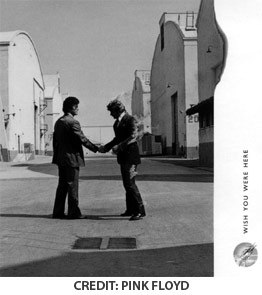Bobbyisms: Diamonds in the machine

I write about random things a lot. I write a lot about random things. Did you know that Pink Floyd's 1973 album The Dark Side Of The Moon was so successful that it appeared on the Billboard charts from its release in 1973 until 1988? The album spent 741 straight weeks on the charts and has sold over 50 million copies since being released; it's the second greatest-selling album of all time after Michael Jackson's Thriller.
Not as many people these days are aware of Pink Floyd as perhaps they should be, a fact at the core of the latest project underway to rerelease their catalogue in new remastered, expanded editions — over 2011 and 2012, EMI has been reissuing the band's classic albums with three new package tiers available based on the sort of experience you're looking to have while you dive into their work.
There's the Discovery edition, which features the albums in their entirety, re-mastered for quality; the Experience edition, which adds a second disc of live music from the recording era; and the Immersion edition, which includes the above plus additional discs loaded with studio takes, alternate mixes from the creative process, extra audio and visual material on DVDs, Blu-ray discs and more — a means to get completely lost in the world of the album and its creation, a veritable time capsule waiting to be opened.
This isn't a story about The Dark Side Of The Moon, however; it's a story about Wish You Were Here, the album that came after the smash. But to tell it, it's important to look back at its predecessors just a bit.
The 1970s were a time of great creativity and turmoil for Pink Floyd, which was comprised at the time of Roger Waters, David Gilmour, Nick Mason and Richard Wright. The band rose to popularity in the late 1960s, but it took the departure of Syd Barrett — their original frontman — for them to become more than simply pop rock experimentalists.
As the 1970s got underway, two things happened that changed the band's sound and direction and made them living legends: first, the band quickly discovered that the best work they recorded were the songs they wrote collectively instead of individually, and second, the band signed a new record deal that offered them less royalties in exchange for unlimited studio time.
The freedom allowed the band to take all the time they needed to hash out their ideas and work together as a unit, and by the time they released The Dark Side Of The Moon, they had not only found their niche as a band in the studio and on the stage, they had transcended into a new breed of rock star and exploded in popularity, especially in the United States.
Despite the fact that they had all the time in the world to create their records, the pressure placed on them after the success of The Dark Side Of The Moon was so great as to strain the members of the band and their relationships with one another. For one thing, they got into a rut in their live shows, constantly performing the album in its entirety for fans of rapidly growing sizes; the band became too big to play intimate venues and grew into stadiums, something they felt didn't much fit with their direction — although by the time they released The Wall in 1979, they had developed an incredible large-format concert experience.
Wish You Were Here was written and recorded in fragments throughout 1975. It speaks volumes of the band's fragile condition at the time, trying to cope with their success and stature, and deals with sensitive issues in the band's inner circles, like the mental deterioration of their former frontman. In a now-famous story told by Waters and Wright, Barrett showed up unannounced at the studio during the making of the record, but his physical state had declined as well — now fatter, balding and pale as a ghost, the band didn't recognize him as he sat and listened to them work. They never saw him again.
Wish You Were Here is a record of broad appeal, far beyond the select audiences interested in the band's progressive rock developments. Its atmospheric bookending in "Shine On You Crazy Diamond" (in part written about Barrett) sees the album rise and fall sonically, like a classical composition from centuries past. The themes on the record deal with distrust and contempt for the music industry — see "Welcome To The Machine" and "Have A Cigar" — while its title track boasts a tender nostalgia to offset some of the candour on the album.
The record is widely available in all three editions — Discovery, Experience and Immersion — and the February 2012 edition of Guitar World magazine has a fantastic article looking into the making of the record, a detailed account of the multiple studio sessions and the band's growing disdain for the music and each other, told by the band themselves. It's a stunning, stark and fascinating look behind the scenes at an album from a time before looks behind the scenes were ever an option.
For more on the continuing project to re-release the re-mastered Pink Floyd catalogue, or to order copies of records already re-issued, visit whypinkfloyd.com. For more of the latest music news, views and streams, follow this column on Twitter @fsu_bobbyisms or via Tumblr at bobbyisms.com.
There is so much more to the Pink Floyd story than I could ever fit in this column. Look into their albums and lore, you won't be sorry. I'm out of words.













